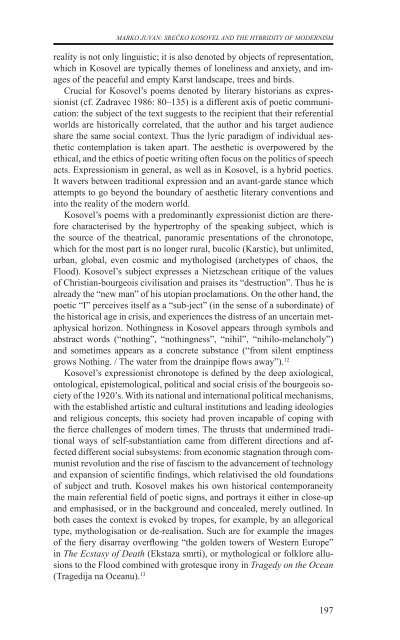razprave (pdf) - Društvo za primerjalno književnost - ZRC SAZU
razprave (pdf) - Društvo za primerjalno književnost - ZRC SAZU
razprave (pdf) - Društvo za primerjalno književnost - ZRC SAZU
- No tags were found...
You also want an ePaper? Increase the reach of your titles
YUMPU automatically turns print PDFs into web optimized ePapers that Google loves.
MARKO JUVAN: Srečko Kosovel and the Hybridity of Modernismreality is not only linguistic; it is also denoted by objects of representation,which in Kosovel are typically themes of loneliness and anxiety, and imagesof the peaceful and empty Karst landscape, trees and birds.Crucial for Kosovel’s poems denoted by literary historians as expressionist(cf. Zadravec 1986: 80–135) is a different axis of poetic communication:the subject of the text suggests to the recipient that their referentialworlds are historically correlated, that the author and his target audienceshare the same social context. Thus the lyric paradigm of individual aestheticcontemplation is taken apart. The aesthetic is overpowered by theethical, and the ethics of poetic writing often focus on the politics of speechacts. Expressionism in general, as well as in Kosovel, is a hybrid poetics.It wavers between traditional expression and an avant-garde stance whichattempts to go beyond the boundary of aesthetic literary conventions andinto the reality of the modern world.Kosovel’s poems with a predominantly expressionist diction are thereforecharacterised by the hypertrophy of the speaking subject, which isthe source of the theatrical, panoramic presentations of the chronotope,which for the most part is no longer rural, bucolic (Karstic), but unlimited,urban, global, even cosmic and mythologised (archetypes of chaos, theFlood). Kosovel’s subject expresses a Nietzschean critique of the valuesof Christian-bourgeois civilisation and praises its “destruction”. Thus he isalready the “new man” of his utopian proclamations. On the other hand, thepoetic “I” perceives itself as a “sub-ject” (in the sense of a subordinate) ofthe historical age in crisis, and experiences the distress of an uncertain metaphysicalhorizon. Nothingness in Kosovel appears through symbols andabstract words (“nothing”, “nothingness”, “nihil”, “nihilo-melancholy”)and sometimes appears as a concrete substance (“from silent emptinessgrows Nothing. / The water from the drainpipe flows away”). 12Kosovel’s expressionist chronotope is defined by the deep axiological,ontological, epistemological, political and social crisis of the bourgeois societyof the 1920’s. With its national and international political mechanisms,with the established artistic and cultural institutions and leading ideologiesand religious concepts, this society had proven incapable of coping withthe fierce challenges of modern times. The thrusts that undermined traditionalways of self-substantiation came from different directions and affecteddifferent social subsystems: from economic stagnation through communistrevolution and the rise of fascism to the advancement of technologyand expansion of scientific findings, which relativised the old foundationsof subject and truth. Kosovel makes his own historical contemporaneitythe main referential field of poetic signs, and portrays it either in close-upand emphasised, or in the background and concealed, merely outlined. Inboth cases the context is evoked by tropes, for example, by an allegoricaltype, mythologisation or de-realisation. Such are for example the imagesof the fiery disarray overflowing “the golden towers of Western Europe”in The Ecstasy of Death (Eksta<strong>za</strong> smrti), or mythological or folklore allusionsto the Flood combined with grotesque irony in Tragedy on the Ocean(Tragedija na Oceanu). 13197
















